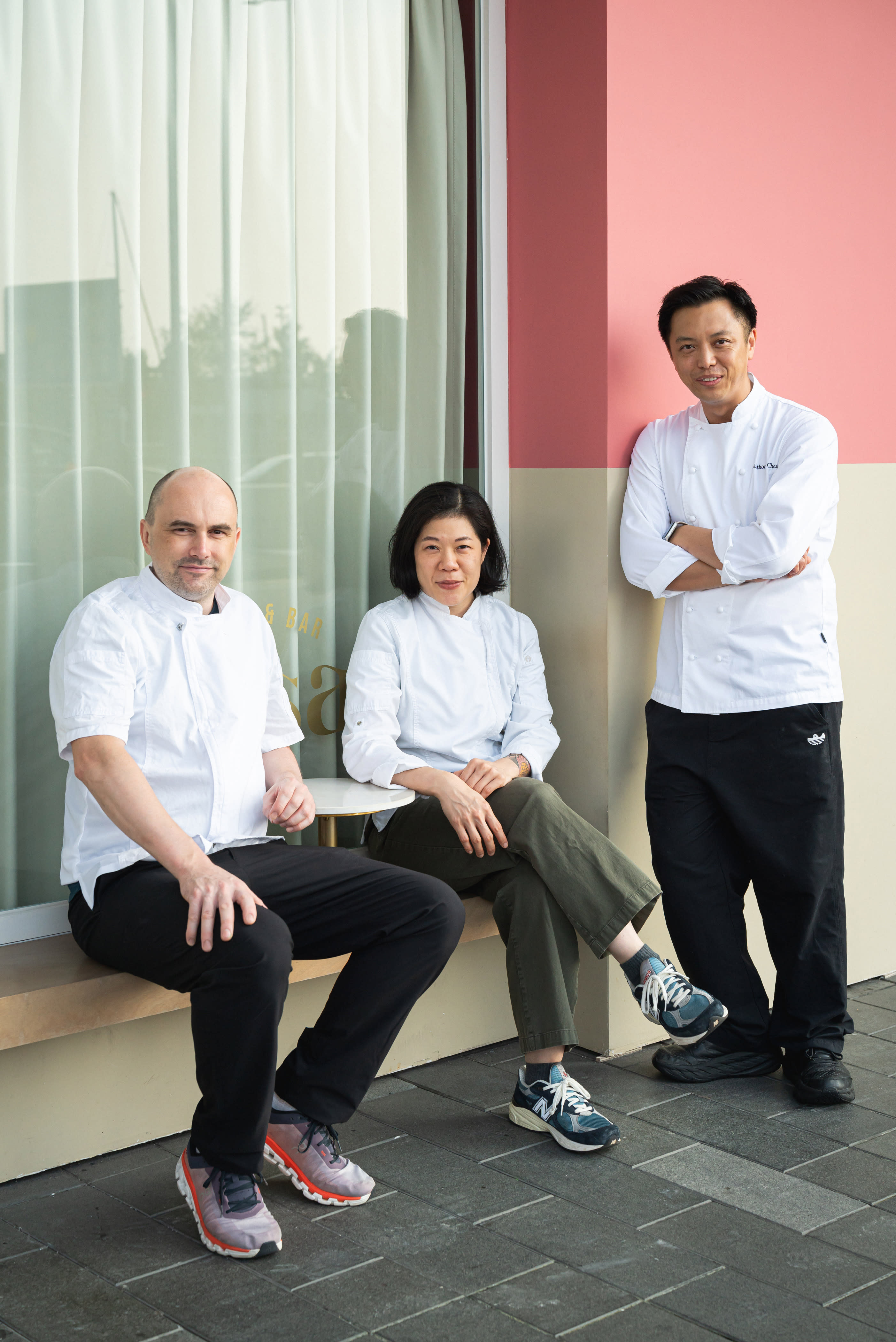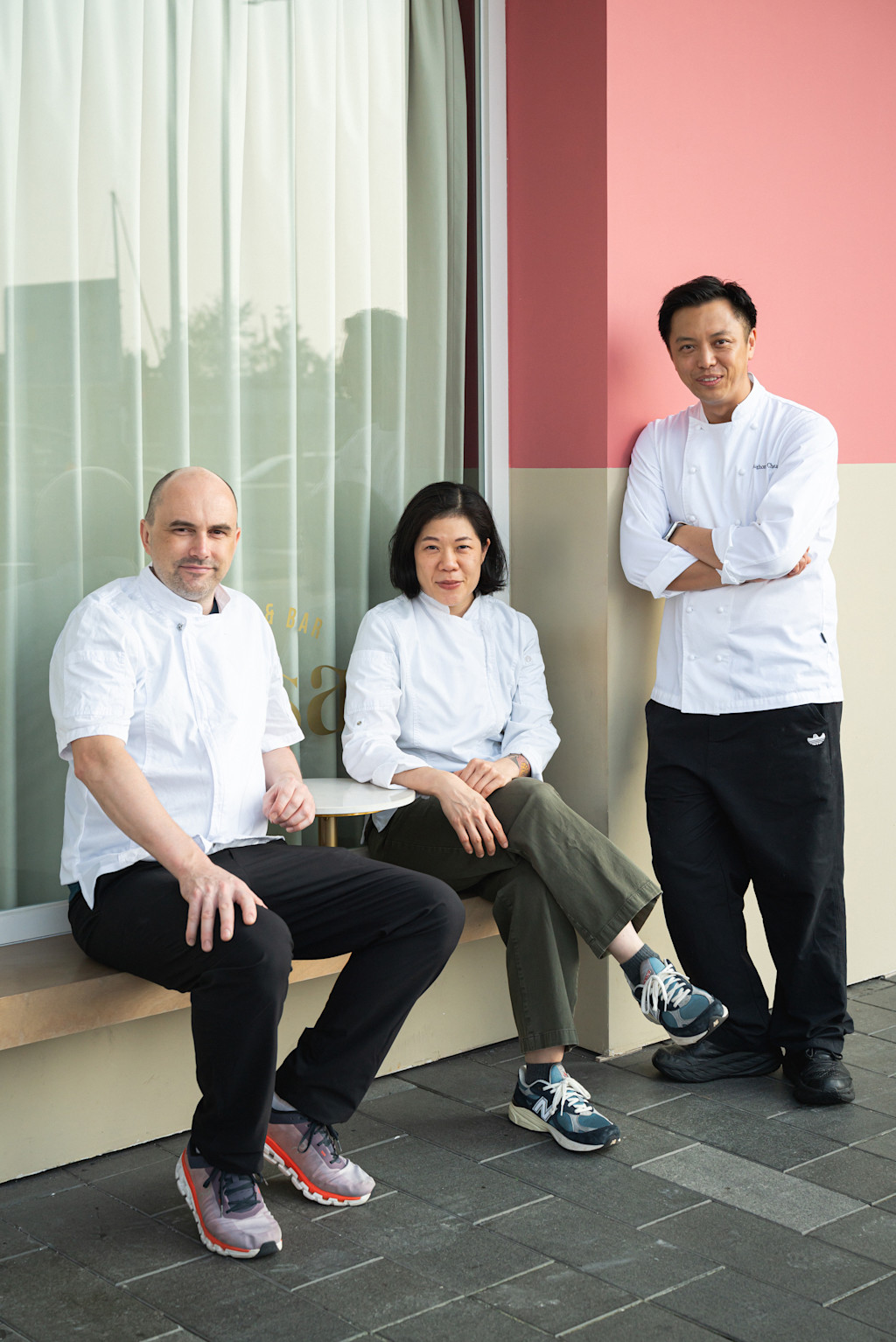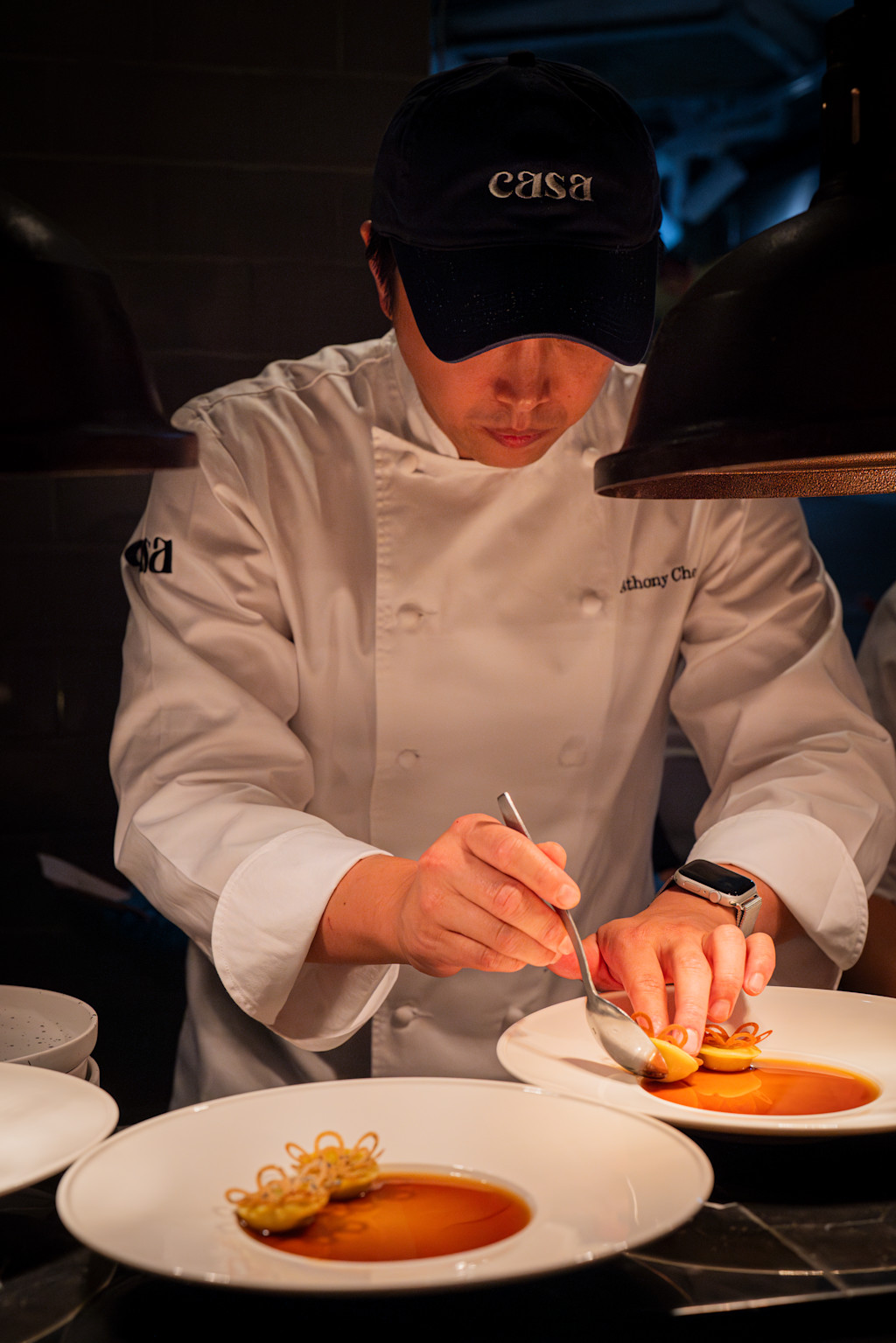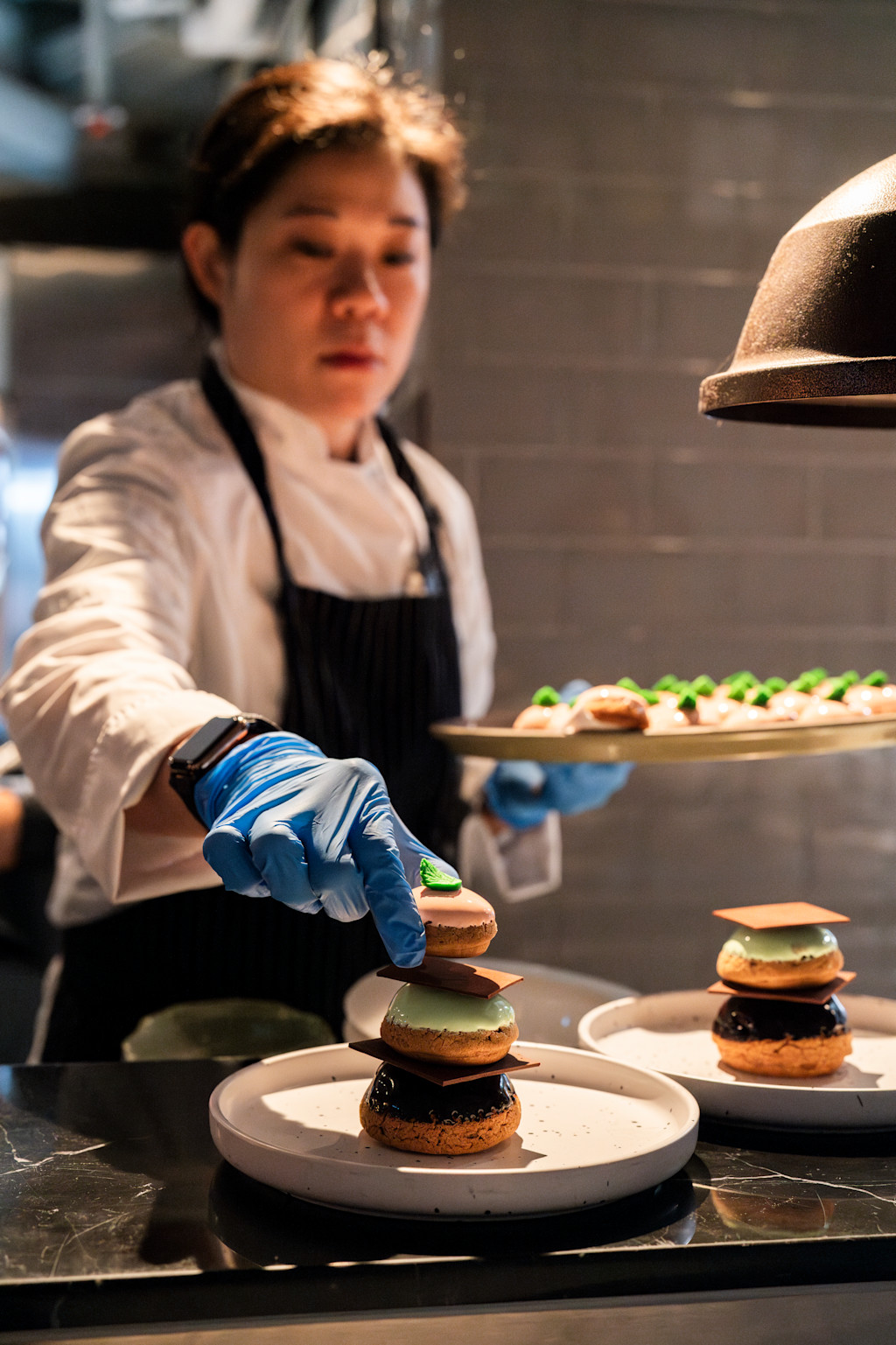Casa Cucina and Plumcot Joined Hands for Our First FOOD+FILM Evening Feast
A sold-out evening of delightful dishes inspired by Wes Anderson’s The Grand Budapest Hotel.

On October 7, we kickstarted our FOOD+FILM campaign with chef Anthony Cheung from Casa Cucina teaming up with Plumcot’s chef Camille Moënne-Loccoz and chef Dominique Yau to create a special, one-night-only menu based around Wes Anderson’s instant classic, The Grand Budapest Hotel. The evening welcomed guests to celebrate the love of food, art, and humanity with delectable dishes such as duck l’orange with truffle and pumpkin; Miyazaki rice-raised pork belly with pickled pumpkin, beetroot, and pork jus; Madagascar vanilla rice pudding with salted caramel and roasted nuts; and a choux pastry trio of orange blossom, pistachio, and Valrhona single origin dark chocolate. To dive deeper into how such an iconic film inspired these three chefs for their wonderful collaboration, we sat down with them for a conversation on all things cooking and Wes Anderson.


CHEF ANTHONY CHEUNG OF CASA CUCINA & BAR
What is your favourite scene in The Grand Budapest Hotel and why?
One of my favourite scenes in The Grand Budapest Hotel is the moment in the beginning when Monsieur Gustave interviews young Zero. Despite Zero having "zero" job experience or formal education, Gustave sees potential in his enthusiasm. This pivotal moment not only marks the beginning of their professional relationship but also evolves into a deep bond that resembles brotherhood.
This scene resonates with me personally, as it reminds me of my own journey starting as a commis in a Michelin-starred restaurant. I was inexperienced and often on the receiving end of harsh critiques. However, over time, I built trust and camaraderie with my team, transforming those initial challenges into lasting friendships. It's a beautiful reminder of how mentorship and support can shape our paths, much like Gustave and Zero's relationship.
I’m excited to share this film during our charity movie night, as it highlights the importance of connection and growth in the culinary world and beyond.
.
Wes Anderson is credited with using ingenious camera work for the film. Does his cinematography inspire your cooking in any way?
Wes Anderson’s cinematography has definitely influenced my approach to cooking. What stands out to me is his ability to make subtle details captivating. His unique colour combinations create inviting backgrounds, and the laser-sharp symmetry in each frame draws the viewer’s eye. The wide depth of field he employs brings every detail into focus, allowing you to appreciate the intricacies of the scene. I could pause any of his films and admire the visuals for hours.
This meticulous attention to detail inspires me in my own culinary presentations. When plating a dish, I pay close attention to colour coordination and symmetry, as I believe these elements can profoundly enhance the dining experience. Just as Wes Anderson crafts visually stunning scenes, I strive to create dishes that are not only delicious but also visually engaging, making a strong impact on the diner.
.
The movie is a visual feast with lovely colours and designs. You are now in Causeway Bay, which is renowned for blending traditional and modern styles that are eye-catching. How do you create your Italian dishes to be just as visually enticing while stimulating the taste buds?
In a city known for its dynamic mix of traditional and contemporary styles, I aim to create Italian dishes that are just as visually appealing and stimulating to the taste buds. My approach starts with choosing fresh, high-quality ingredients that not only taste great but also offer a spectrum of colours. For instance, I love incorporating vibrant vegetables, herbs and garnishes to create a colourful palette on the plate.
Presentation is key; I focus on plating techniques that emphasize symmetry and balance, much like the visual artistry seen in The Grand Budapest Hotel. I often play with height, layering elements to add depth, and I use unique serving dishes to enhance the overall aesthetic.
Additionally, I believe that the overall dining experience goes beyond just the food. I consider the ambience of Casa Cucina, using lighting and decor that complement my dishes, creating an inviting atmosphere that enhances both the visual and sensory experience. Ultimately, my goal is to craft dishes that not only please the eye but also delight the palate, inviting diners to savour each bite.
.
The movie mixes tragedy, nostalgia, war, and, of course, comedy into a masterpiece of 100 minutes. How do you ensure that customers who come for an evening have a great blend of emotions while sampling your food?
Creating a memorable dining experience is much like crafting a film that blends various emotions. At Casa Cucina, I aim to evoke a range of feelings through my food and the overall atmosphere.
To start, I focus on the joy of flavours. Each dish is crafted with care, using fresh ingredients that celebrate the essence of Italian cuisine. I want diners to experience happiness with every bite, whether it’s the warmth of a comforting risotto or the brightness of a perfectly balanced dessert.
Beyond the food, I pay attention to the ambience. Soft lighting, inviting decor, and thoughtfully curated music can transform a meal into an emotional journey. I encourage interactions among guests, whether through communal dining or engaging with my team, fostering a sense of community that enhances the experience.
I also love to share stories behind the dishes, connecting them to personal memories or cultural traditions. This storytelling invites diners to reflect and feel a deeper connection to their meal, creating a beautiful blend of nostalgia and joy. Ultimately, my goal is to ensure that every evening at Casa Cucina leaves customers with a sense of happiness and fulfilment, much like the emotions evoked in a great film.
.
How do you make the food and drinks you serve as enjoyable as watching an Oscar-winning movie?
I focus on creating a multisensory experience. I prioritize quality ingredients and authentic recipes, ensuring each dish tells a story and offers layered, complex flavours.
Presentation is crucial; I aim for visually stunning plates that captivate the eye, similar to cinematic artistry. Drink pairings are thoughtfully crafted to complement the meal, enhancing the overall experience.
Creating an inviting atmosphere through lighting, music, and decor sets the mood, encouraging connection among guests. Ultimately, I strive to leave diners with lasting memories, much like the impact of a great film.

CHEFS CAMILLE MOËNNE-LOCCOZ & DOMINIQUE YAU OF PLUMCOT
What's your favourite scene from The Grand Budapest Hotel?
The montage starting with M. Gustave placing a phone call from a middle-of-nowhere phone booth to solicit help from the (very secret) Society of the Crossed Keys.
.
The movie is famous for Wes Anderson's quirky cinematography, among other elements. How does quirkiness play out in the breads and other foods that you make every day?
We implement a sense of quirkiness through unexpected ingredients, such as using a blue cheese we like from the Auvergne region in France to make ice cream. The result is a sweet and savoury adventure that has proven to be popular among our customers.
.
The colors of the movie are spectacular and bring the viewer a lot of joy. Do you try to provide your customers with something joyful with every bite of your food?
It is certainly one of our goals to instil joy through our food, which is such a powerful medium. At its core, it is a source of sustenance that everyone needs to survive. Beyond that, food is something that brings people together: family, friends, and loved ones. Food can be as simple or as complex as you make it, and often, when you discover good food, you want to share it with the people you love. Most of our food is in a portable format — be it a buttery and flaky croissant or a decadent dark chocolate cake. We hope to make it just a little easier for people to come together, sharing food, and stories, and creating new lifelong memories.
.
Do you ever cook or bake a feast that carries a mixture of emotions, just like the movie, which featured a blend of comedy, tragedy, war, and nostalgia?
I'm sure we won't be the only ones referencing Proust and the connection between food and memory in this book! This aspect of the food experience demands more involvement and "work" from the participant, who will each bring his or her own special meaning to the table (excuse the pun). The connection between food and our daily lives is so strong that we’ve all had thoughts starting with "This reminds me of..." when we first bite into a morsel of food. Often, it is not a feast but a humble dish or treat that conjures up the most intense emotions. Referencing another movie, it would be the Sorrowful Rice (roasted pork belly rice) in God of Cookery. At Plumcot, you can also find some pretty darn good madeleines.
.
How different do you think cooking and filmmaking are as art forms, and how are they similar?
Both mediums are creative expressions that involve a lot of planning, technical skills, and teamwork. They engage our senses and invoke our emotions. Like filmmakers, chefs can tell a story and take their audience on a journey through a series of courses from appetisers to desserts, setting the scene and tone for the meal. The dining room, the lighting, and the service all play a part and can be manipulated to convey the message. In cooking, we have the advantage of engaging the senses of smell, taste, and touch in addition to sight and sound, which are primarily involved in a cinematic experience.
The main difference between the two art forms, for me, is that cooking is transient. There isn't a permanent copy of the meal that accurately recreates the whole experience every time; there is no "Play" button. Neither visual evidence in photographs nor videos captures the smell or taste of the food at that particular moment when you experienced it.
Generally, I think there are more similarities between the two than first meets the eye.
